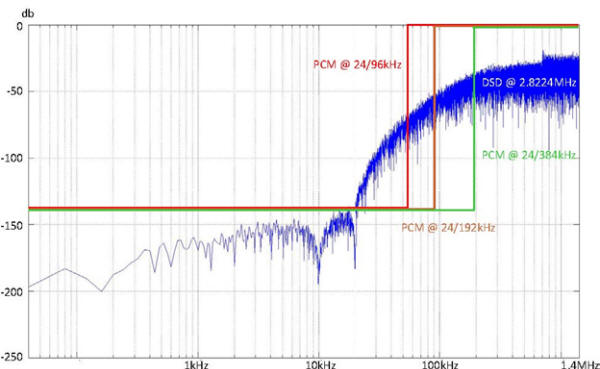It is not. Multi-bit PCM quantization noise can be completely eliminated because we have so much headroom. Indeed, 24-bit audio is "self-dithering" in that there is natural noise in the right order bits so even out of the box, it is distortion free. If one wanted to have lower noise floor still, the same noise shaping used in DSD can be utilized to push the noise to ultrasonics.
The AES paper has good simulations of this. It shows that when driving by one or two pure tones, there are harmonic distortions that are just 32 db below the signal! Of course, the frequency by then is well into ultrasonics. So how audible those distortions are is subject to debate. More on this below. PCM on the other hand, has no harmonic distortion so is completely superior in this regard. The bats get to enjoy PCM far more than they do DSD.
Well, per above, PCM does not have distortion. Due to the fact that we can dither multi-bit PCM, we have no distortion at all. So it is a curious case that a system with distortion would be preferred.
Andreas' article talks about that. But with high sampling rate PCM, we are free of that in the audible band. This is the point I wanted to make earlier. See this graph from the article:

The noise above 20 Khz in DSD escalates at the rate of *140* db per decade!Someone needs to tell me the purpose of this system. If it is there because we supposedly hear ultrasnonics, why would we want to trash everything that is there this way? I mean either frequencies >20K are audible or not. If they are audible, then we should preserve them as we do with PCM. Not throw both noise and distortion in there.
This is the most important point. The AES article touches on it. It says that maybe the reason we like DSD is because the ultrasonic distortion in our speakers and amps, causes them to sound different in normal audio band.
It is also possible that somehow our ear responds differently when excited by ultrasonic content. This would explain why we don't hear it but why it might have an effect. In this scenario, it is entirely possible that what we want to hear is not the original content of music but the distorted version. Perhaps this is why analog sounds good because it probably has a lot of junk going on there too. I am making this stuff up as I go of course. But I can't come up with a different explanation of why I also like *high sampling rate* PCM converted to DSD.
Again, high sampling rate PCM should not have an issue here. And at any rate, DSD is often filtered also at playback. If that is a digital filter, it will also ring.
As I mentioned, the Koch article is marketing material. It makes statements like "it is proven we can hear 100 Khz" impulse or some such thing. What proof? Proof needs to be presented with references and there is none here. And then he moves on to show the above graph. If we care up to 100 Khz, why would we want the system response to look like that? Did the test that prove 100 Khz was audible use such a distorted response?
Bottom line is that DSD system is not linear. And can have tones and noise floor that is modulated by the input signal. Its foundation came from an approach to make DACs/ADC converters cheaper to make. And it came at a time when both Sony and Philips CD patents were expiring and they had to cook up something proprietary.
I was at the AES conference where a panel consisting of the authors in the AES paper (professors Lipshitz and Vanderkooy) and Sony/Philips were present. The content of the paper was shown using proper technical/mathematical analysis. Then everyone turned to the Sony/Philips folks and I was surprised that they provided no defense other than it sounds good anyway! Philips did present a counterpoint in the next conference but I have to say, despite preferring the sound of DSD, it was a let down. It was clear that smart signal processing people were not in the design loop of DSD.
If I surveyed 10 signal processing expert, I suspect every one of them would say DSD is flawed and has no advantage over PCM. I have yet to see anyone other than Sony/Philips folks praise it. There may be some that are out there but I have not seen them.
So to summarize, you prefer the sound of DSD, but the measurements show it's flawed. So maybe we're not measuring the right thing or as Andreas suggests, there's some psychoacoustics at work.
Sorry but I don't see this as marketing material but a basic introduction for the average audiophile on what DSD/SACD is about. BTW, Andreas Is probably one of the foremost experts on subject of DSD (he was also with Meitner---and Ed was a consultant to Sony) and his PD is the best digital playback system I've heard to date. Might I add Andreas has implemented some unique things in his digital gear.










